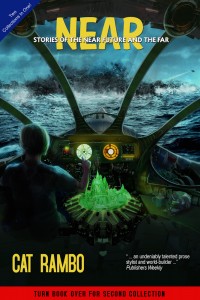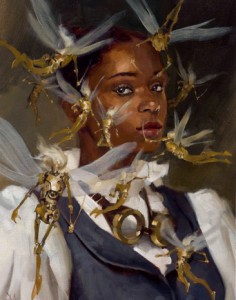Arthur C. Clarke’s “The Star” (winner in 1956) actually violates what I tell my students. It’s the sort of name, an article and common noun, devoid of verb that I would circle on a paper. But it’s such a classic story of its time, shamelessly yanking out every emotional stop, and so it’s pretty easy to see why it was that year’s winner.
Past that, others bear out my thesis. Avram Davidson’s “Or All The Sea With Oysters” (winner in 1958) is a stylish killer of a title, carrying a whiff of Caroll-esque steampunk long before its time. Robert Bloch – “That Hellbound Train” (winner in 1959) (What train, the reader wonders, what is it like, who are its riders?); Anton Lee Baker – “They’ve Been Working On…” (nominee in 1959) (Who are they? What are they working on, and why does the author give us that trailing off, that textual pause of the …?); Alfred Bester – “The Men Who Murdered Mohammed” (nominee in 1959) (Murder’s a sinewy lump of a word that sometimes overpowers the rest of the title, but here it’s effective as can be.); Algis Budrys – “The Edge of the Sea” (nominee in 1959) ( plain language in a poetic construction, which manages to pull it off given that Bester is usually a guarantee of decent quality that will justify it); C.M. Kornbluth – “The Advent on Channel Twelve” and “Theory of Rocketry” (both nominees in 1959) (simple but powerful); and then Fritz Leiber’s audacious and (imo) funny as hell “Rump-Titty-Titty-Tum_Tah-Tee” (nominee in 1959).
Look at the more recent stuff if you don’t have time to delve lovingly through that list (which I think would be a useful exercise for any writer, I plan on doing it myself), which continues to support my claim. There’s Michael Swanwick’s “The Very Pulse of the Machine” (winner in 1999), “Scherzo with Tyrannosaur” (winner in 2000) and “The Dog Said Bow-Wow” (winner in 2002), David Langford’s “Different Kinds of Darkness” (winner in 2001), Neil Gaiman’s “A Study in Emerald” (winner in 2004), David Levine’s “Tk’tk’tk” (winner in 2006), Elizabeth Bear’s “Tideline” (winner in 2008) (short and sweet and powerful), Ted Chiang’s “Exhalation” (winner in 2009), and most recently Will McIntosh’s “Bridesicle” (winner in 2010).
The writer can’t afford to throw away the possibilities of the title, there’s just too much chance to set the hook in the reader there with the right cast. Make your lure beautiful, jingly with poetic principles, flashy or intricate or if you’re among the most daring, something so simple and beautiful in its form that it’s irresistible. Load it with the sensory or weight it with muscular verbs, but make it pull the reader in so your first three paragraphs can render them helpless and absorbed and yours for the story.
A title’s often the last thing I add to a story in completing it. I may go hunting through books of poetry to find something suitable, or listen to song lyrics, or even just daydream about verbs. I may comb through the piece looking for images or particularly lovely lines, particularly ones that occur in moments of high tension, revelation, or in the last few paragraphs.
What’s your favorite title – either your own or someone else’s?






